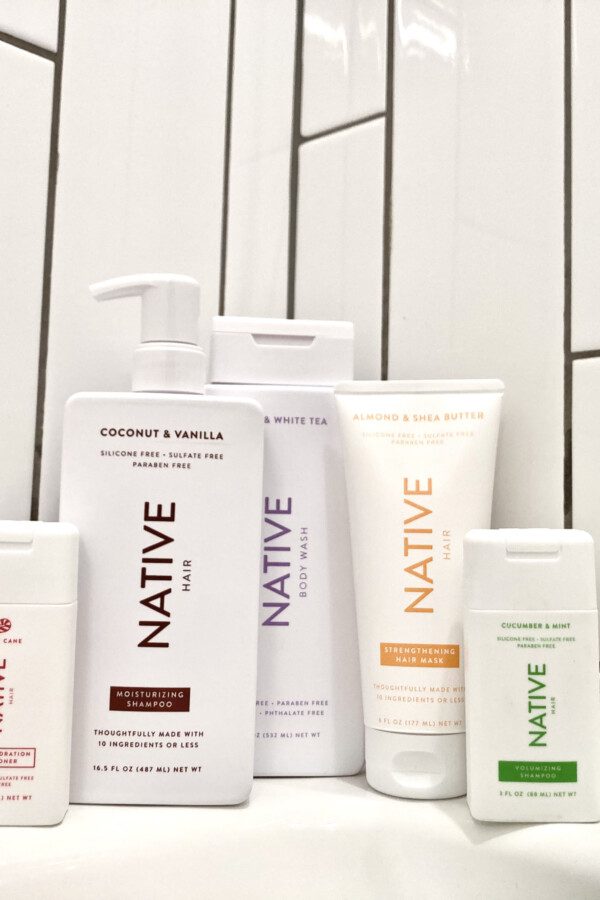With the pandemic came a surge in online grocery shopping and cooking at home. But even as the pandemic has subsided, there are a lot of benefits to shopping from online-only natural food stores: it can save time and be more convenient, it can save money, and it can help you shop according to your needs and values more easily.
Corporate behemoths like Amazon and Walmart offer online food ordering and grocery delivery services, but you may wish to stay away from those companies when possible, for a variety of reasons. The good news is that companies like Thrive Market are proving to be a truly competitive service, making it much easier for consumers to make the switch.
Plus, as we’ll see in a moment, online grocery shopping can not only be a great solution for individuals and families, but it can also help to alleviate food insecurity in many parts of the country.
Table of Contents
This guide contains affiliate links, which means we may earn a commission if you decide to make a purchase. As always, we only make recommendations that are genuine.
Why Organic Food is Better
Before discussing the cost of online organic and natural food stores, some may ask: is organic food really better for you? In short, the answer is yes.
Non-organic food is sprayed with carcinogenic (cancer-causing) pesticides and herbicides that can cause a whole host of problems over time, both on one’s individual health as well as on the environment as a whole.
In addition to cancer, pesticides have also been linked to things like digestive issues, decreased fertility in all genders, ADHD and autism in children, as well as Parkinson’s in older adults.
This makes sense when we consider the fact that many of the herbicides that are used today were originally developed to be poisons like Agent Orange.
Organic food also has more nutrients most of the time. Considering that many people are severely nutrient deficient, organic food can help to solve that problem. It is often more flavorful as well!
Not only that, but there are many reasons that organic crops are better for our communities and society in the long run. Whereas conventional monocrop farming strips topsoil, organic and regenerative farming maintains the healthy soil that future generations will need for their food supply. Organic farming also helps to protect our pollinators (which necessary for food production and healthy ecosystems, but are endangered). Not only that, but millions of dollars in subsidies are given to conventional farmers each year in order to keep them running. Therefore, organic agriculture can save taxpayers’ money as well.
Those that are in more sensitive populations (pregnant women and babies, people with chronic illness, etc.) will find it even more important to eat organically since they are at a higher risk for the negative consequences of pesticides.
Why is Organic Food More Expensive?
Many people are resistant to shopping from natural food stores because they believe buying organic is more expensive. This is, of course, a very real and valid concern.
While organic food can be more expensive, it’s not necessarily always the case. Depending on things like the store, product, and season, buying organic food may be of equal or maybe even less cost compared to non-organic groceries. There are a lot of factors in play!
One reason why non-organic food may be cheaper is because of the large government subsidies for monocrop farmers, as noted above. While these subsidies may help decrease our grocery bills, taxpayers are really just spending that money in a different way.
Not only that, but the majority of organic and regenerative farms also pay their workers fair wages—something that cannot necessarily be said of many non-organic farms. A tomato that’s harvested by someone being paid a living wage is likely to cost a bit more than a tomato harvested by someone stuck in bonded labor.
Organic certifications can be costly, too, especially for smaller farms that are working with thin profit margins. For this reason, some farms that use organic growing methods may actually choose not to get an organic certification, choosing instead to pass that savings on to their customers. Don’t hesitate to ask your local farmer if they grow organically, even if they don’t have a certification.
Let’s also think about the true cost of non-organic food over a longer period of time. Eating healthier and more organic foods can help prevent a whole host of health issues down the road, from diabetes and heart disease to chronic illness and depression. So even if some organic foods are more expensive in the short term, you are likely to save in expensive healthcare costs in the long run. And this isn’t even to mention the diminished quality of life that many of these health conditions can bring — which is something you can’t put a dollar amount on!
When considering the long-term costs to our individual, communal, and environmental costs, one could easily argue that non-organic food is actually much costlier!
If you are trying to balance the budget but also want to decrease the amount of non-organic food you consume, you can consider using the Environmental Working Group’s Dirty Dozen and Clean Fifteen when shopping for produce. Each year, the organization does extensive tests on produce in order to determine which types of fruits and vegetables are most likely to contain high amounts of pesticides (like strawberries) and which ones are least likely to have high amounts of pesticides (like avocados). That means when you’re grocery shopping, it’s recommended that you spend a little more on organic strawberries, while you can feel safe saving money on the non-organic avocados.
All that being said, organic food does not always have to be more expensive. Because of the business models of many of the companies below, shopping online from organic food stores doesn’t have to break the bank!
Body
Is Microwave Popcorn Healthy or Bad for You?
It turns out, most microwave popcorn comes with chemicals that are known to cause long-term health problems in humans. Learn about what those chemicals are, and which are the healthiest popcorn brands.
Is Online Grocery Shopping Cheaper?
So, now we know that shopping from organic and natural food stores is not necessarily always more expensive, but can grocery shopping online help you save money while helping you eat healthier? We say—yes!
The first way that grocery shopping can save you money is by cutting out the middlemen. Thrive Market, for example, says they offer prices that are 20-25% below the typical retail prices, as illustrated by this simple flow chart:

Online grocery shopping can also save a significant amount of time (and time is money, right?!). By not having to drive to the store, walk around, wait in line, ring everything up, drive home, etc., you can make your shopping much more efficient. You can use that extra time to make more money, spend time with loved ones, or get some much-needed rest.
Plus, when you’re walking through the aisles of the grocery store, it can be much easier to make impulse purchases. You might see something you want or forgot you “needed,” throw it in the cart, and before you know it, you’ve added an extra $50 onto your bill. When you shop online, a significant portion of impulse shopping can be eliminated. You’re most likely just searching for what you need using a search bar instead of passing thousands of other products on the way to check things off your list.
Not only that, but it can be much easier to stick to your budget when shopping for food online. You can always see what the subtotal of your cart is, so there is no carrying around a calculator or getting up the cash register and being surprised because you underestimated what your balance would be.
Lastly, it can be easier to find coupons and compare prices when shopping online versus in-store. When you add all of these factors together, shopping online can most definitely help to save you and your family money.
What Are Food Deserts?
There’s another potential benefit to online grocery stores; this advantage is a communal one.
A food desert is essentially an area that doesn’t have a grocery store nearby. More specifically, it’s often used to describe a place where fresh produce and healthy foods are unavailable or difficult to access.
Not surprisingly, we will find food deserts in America in and around low-income zip codes and in the middle of the country. Food deserts are also more abundant in minority neighborhoods.
The USDA has an interactive Food Atlas map, which allows you to toggle all sorts of different characteristics (like grocery store access, farm sales, or food assistance) to get an idea of where the food deserts are in the U.S.
Why Are Food Deserts a Problem?
This lack of access to natural food stores is a problem for many reasons, many of which can create a spiraling effect, with one factor exacerbating another. Unfortunately, the 2020 pandemic has only made matters worse for many families living in food deserts.
Food Deserts and Physical Health
A lack of healthy food and necessary nutrients can lead to a host of serious physical ailments, from type 2 diabetes and heart disease to cancer and Alzheimer’s, and ultimately, to premature death. In addition to these chronic diseases, an unhealthy diet can increase inflammation, decrease immune function, and put one at greater risk of contracting communicable diseases.
Food Deserts and Mental Health
Those vitamins and nutrients are also needed for adequate mental health, too. Children who are nutrient-deficient are likely to have a harder time in school and may have social or behavioral problems which could significantly affect their success throughout school and ultimately set them on a difficult path for life.
For adults, nutrient deficiency can trigger or worsen conditions like depression, anxiety, ADHD, and others. Not only that, but one’s diet can have impacts on nearly all areas of live, from career to relationships.
Food Deserts and Communal Wealth
We already know that food deserts affect communities that already have lower socioeconomic status. But food deserts can also help prevent those communities from increasing their socioeconomic status too. Consider the food desert cycle which fulfills itself: communities have low levels of wealth, so fewer grocery stores are built. With less access to a basic need like healthy food, people don’t move into those areas (and other people move out). With less people moving into the area, there is even less incentive to build natural food stores in those areas. Therefore, the communal wealth decreases even more. It’s a downward spiral.
How Online Grocery Shopping Could Help Alleviate Food Deserts
Before the internet, if those living in food deserts wanted healthy food, they basically had two choices: 1) Drive really far for groceries. Or 2) Grow it themselves.
But now, with online natural food stores, those in food deserts have increased access to healthy food, which can help to alleviate some of the problems that living in a food desert can cause or exacerbate. Although online grocery shopping may not be an ideal or long-term solution to the food desert problem, it can certainly provide a helpful option for individuals and families experiencing a lack of available healthy food options.
What About Whole Foods Delivery with Amazon Prime?
Whole Foods is probably one of the most well-known natural foods stores in America. It also has a reputation of being pretty expensive. When Amazon bought Whole Foods in 2017, it claimed it would be able to lower some of the store’s prices as well as make grocery delivery more even more accessible through Amazon Prime.
Is Whole Foods Expensive?
According to The Grocery Store Guy, Whole Foods is more expensive than a typical grocery store not only because organic and higher quality foods tend to cost more, but also because “you also are paying for beautiful decor, improved customer service, and better product knowledge.” Sure, you’re likely buying higher-quality ingredients, but you’re also buying an experience.
When Amazon purchased Whole Foods, however, the company claimed it was going to be able to cut prices, making Whole Foods’ products more financially accessible. And while that was true of some products, they didn’t cut prices across the board. So depending on what you buy at Whole Foods, it may not have helped your wallet at all. Overall, Whole Foods still costs more than other natural food stores like Trader Joe’s.
If you’re an Amazon Prime member, you can save 10% on all of your purchases at Whole Foods, which can definitely help bring down the bill! Considering that an Amazon Prime annual membership costs $119, you’d start saving money after you spend $1,190 at Whole Foods (that’s about $112 per month).
Is Whole Foods Delivery Free?
Whole Foods delivery is not free for everyone, but it is free for Amazon Prime members… but only in select cities. While this is certainly convenient for some, it doesn’t help those in food deserts (and a lot of other locations, too).
Is Amazon Prime Worth It?
Amazon Prime costs $12.99 per month or $119 per year. If we’re just talking about groceries alone, whether or not Amazon Prime is worth it to you is most likely going to depend on whether you like shopping at Whole Foods and whether you live close to one. If you don’t, then Amazon Prime probably isn’t worth it for you when it comes to grocery shopping.
Amazon Prime and Whole Foods doesn’t make the cut for this article not only because of the fact that Whole Foods delivery is inaccessible in most areas, but also because of Amazon’s track record of environmental irresponsibility, strong anti-union stance, history of tax evasion, and penalization of small businesses.
The good news is that there are some really great natural food stores that make online grocery shopping super easy!
Best Online Natural Food Stores
If you’re looking for natural food stores that deliver everything from non-perishables to snacks to meat to wine, here are the best places to shop:
Thrive Market
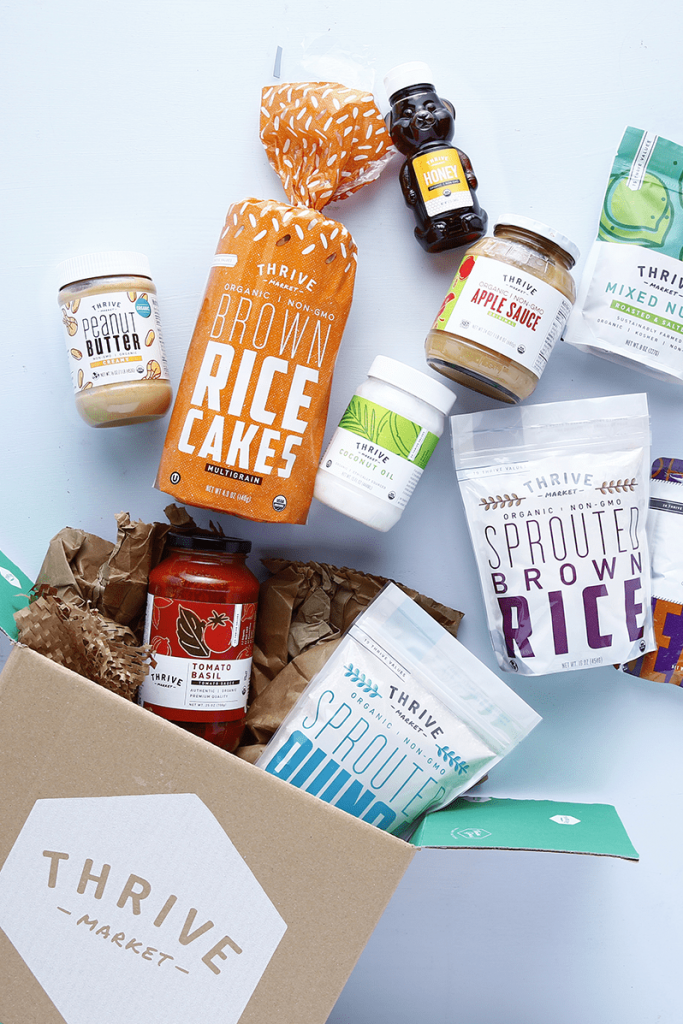
What is it? Online natural and organic grocery store.
Carries: A wide variety of goods, from pantry staples and meat to skincare and supplements, and more.
Dietary Needs & Preferences: You can shop by pretty much any dietary or lifestyle preference there is!
Features:
- Thrive Market probably has the widest variety of product offerings of all the brands on this list, so it’s a convenient one-stop-shop (except for your fresh produce).
- Has a lot of lower-priced items, including their Thrive branded products (usually 25% to 50% below retail).
- You can get a full refund after 30 days if you’re not satisfied.
- There’s no auto-shipping, so there’s no chance you accidentally order and get charged for something.
- Free shipping on orders over $49.
- Every paid membership is matched with a free one for a low-income family, student, teacher, veteran, or first responder.
- They have a savings guarantee, which means that if you don’t make your membership fee back by the end of the year, they’ll give you back the difference in Thrive Cash.
- You can get frequent extra discounts and free products as a member.
- They make it easy to shop by very specific needs and values.
Ships to: Contiguous U.S.
Model: Membership. Here’s how it works:
- Try a risk-free, refundable 30-day trial
- Shop and order what you want
- Cancel anytime
How much does Thrive Market cost? The membership is offered on a yearly basis for $59.95 or a monthly basis for $9.95. Thrive Market says that the average person saves around $30-$32 on each order, so it takes two orders to make up for your annual membership cost.
Cons:
- You can’t get fresh produce.
- Paid shipping on orders less than $49.
- Annual membership required.
- Some items require you to buy multiple at once.
BEST FOR: Most of your groceries (except produce), personal care products, and household goods.
Public Goods
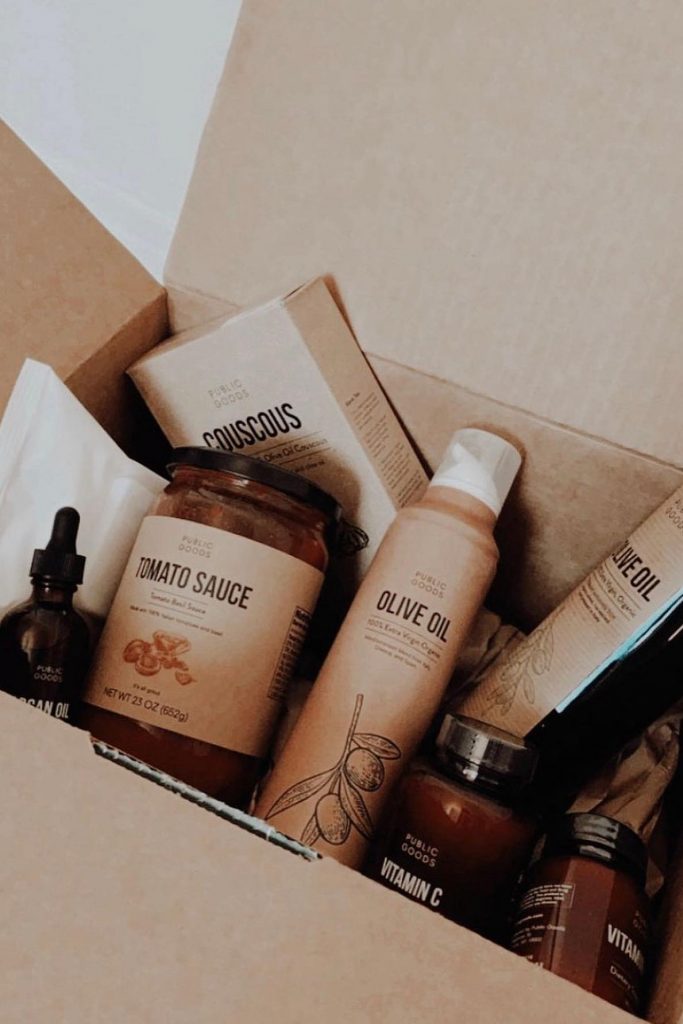
What is it? An online grocery store that carries pantry staples like baking supplies, snacks, spices, tea, canned goods, pasta, and more.
Dietary Needs & Preferences:
Features:
- Convenience: you can buy multiple categories of goods in one place, so you can get your cleaning supplies and personal care items delivered with your groceries.
- Prices are generally more accessible compared to other online natural food stores.
- They take many steps toward sustainability, such as planting trees, using sugar cane instead of plastic for bottles, offering bulk refill options, giving back to non-profit organizations, and more.
Ships to: U.S. and international
Model: Membership. Here’s how it works:
- Try it out with a free, two-week trial membership.
- Annual membership is $59 after your trial ends.
- Membership will be automatically renewed (but you can cancel at any time).
- There is no auto-shipping so you don’t buy what you don’t need. Just place an order when you’re ready for a restock.
Cost: $59 annually, plus the cost of goods (which are on average cheaper than other online natural and organic food stores).
Cons:
- Not all of their food products are organic, gluten-free, non-GMO, etc. However, they do provide clear labeling to make it easy for customers to shop according to their priorities.
- All of their cleaning and personal care products meet a minimum low-tox and sustainable standard, but some of their personal care products are safer than others.
- No produce.
BEST FOR: Pantry staples!
Hive
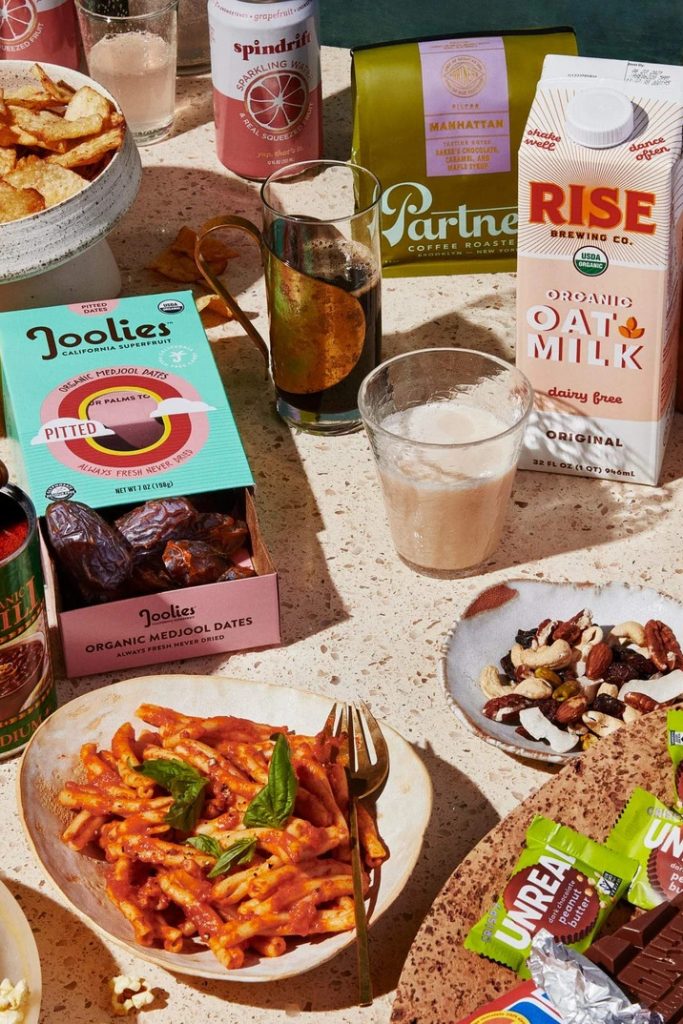
What is it? An online grocery store that carries pantry staples, snacks, beverages, personal care products, and home goods.
Dietary Needs & Preferences:
Features:
- No memberships or fees.
- Orders over $50 ship free.
- They have a great filtering system that allows you to sort by as many preferences as you want. So if you’re looking for something that’s specifically gluten-free, vegan, fair trade, BIPOC-owned, and plastic-free, you got it.
- Their “Hive Five” criteria vets brands based on Ingredient Integrity, Recyclable Packaging, Low Carbon Footprint, Commitment to Social Good, and Rave-Worthy (a.k.a tastes great!).
Ships to: We’re unsure. We’ve reached out to the Hive team and will update soon!
Model: Hive is not a membership or subscription model, so it works just like a regular online store! Just pick out what you want, put it in our cart, and check out.
How much does Hive cost? Since there are no extra fees, most products that Hive carries are priced similar to how those same items would be priced in an average American grocery store.
Cons:
- Orders under $50 cost shipping (but it’s only a flat $5.95.)
- No produce.
BEST FOR: Pantry staples and snacks!
Best Food Delivery Subscriptions
If you’re not looking for a standard online grocery store, but rather a subscription service, below are our recommendations for the best brands—from meal kits to produce to meat!
Sunbasket
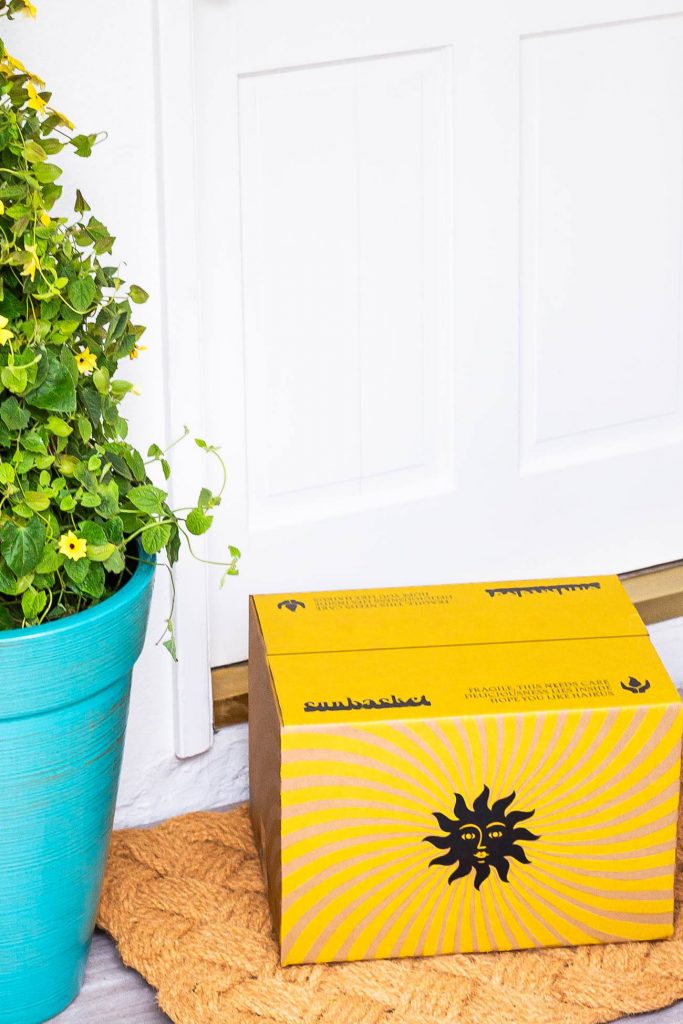
What is it? Customizable meal kit delivery subscription.
What’s on the Sunbasket Menu? Sunbasket carries meal kits for the following dietary needs and preferences:
- Paleo
- Lean & Clean
- Gluten-Free
- Vegetarian
- Carb-Conscious
- Pescatarian
- Mediterranean
- Diabetes-Friendly
- Chef’s Choice
- Fresh & Ready
Features:
- Focus is on dinner meals, but you can add breakfast and lunch if you want
- Certain meals are marked as *Speedy, which means you can make them in 20 minutes or less
- 100% USDA Certified Organic Produce
- Fisheries are certified by the Marine Stewardship Council (MSC) and fish are caught using low-impact methods.
- Eggs, milk, and yogurt are organic, with some organic meat and poultry options. You can learn more about the specific farms on their website.
- Meat is antibiotic- and hormone-free and animals are treated according to their set of Animal Welfare Standards.
- Working on getting to 100% recyclable and/or compostable packaging.
- An average of 1,000 pounds of food is donated each week to various non-profit organizations.
Ships to: Most zip codes in the United States, excluding AK, HI, and parts of MT, NM, and ND.
Model: Subscription. Here’s how it works:
- Your order arrives cold-packed at your doorstep.
- Follow simple cooking or heat-only instructions.
- Skip a week or cancel your meal plan anytime.
What Does Sunbasket Cost? Prices range from $10.99 to 12.99 per meal.
Cons:
- While they claim all their meat is sourced responsibly and sustainably, it is not all certified organic.
- All meals are prepared in the same facility, so if you have severe allergies or intolerances, you should not use SunBasket.
BEST FOR: Easy & time-saving meal kits!
ButcherBox
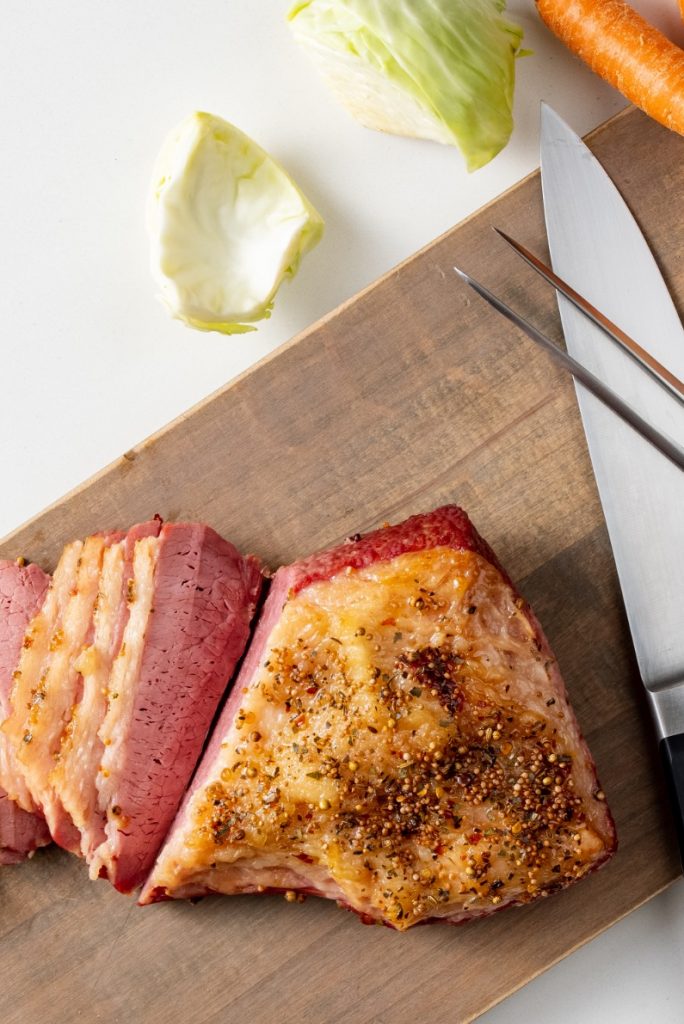
What is it? Organic and grass-fed meat subscription service.
Carries: Grass-fed beef, free-range organic chicken, heritage-breed pork, and wild-caught salmon (& other seafood)
Features:
- Shipping is free.
- Beef is humanely and pasture-raised in Australia, where animal welfare standards are very high. Beef is 100% grass-fed and grass-finished.
- Heritage-breed, antibiotic- and hormone-free pork is humanely raised and all vegetarian fed.
- Chicken is humanely raised and free-range. Both the chickens and their feed are USDA certified organic.
- Salmon, scallops, lobster, cod, and halibut is wild-caught and contain no artificial coloring or other additives.
- Is a B Corp certified company, which means it meets a minimum set of ethical standards.
Ships to: All 48 contiguous United States.
Model: Subscription. Here’s how it works:
- Choose from pre-made boxes or a custom box (the most popular option).
- Choose your box and delivery frequency.
- Get meat delivered to your door, and delay your next box whenever you need to.
How much is ButcherBox? The price per pound for ButcherBox’s meats usually ranges between $10 and $15. That ends up being about $4 to $6 per meal.
Cons:
- Meat comes frozen, which may or may not be a con depending on if you prefer it fresh.
- Can be a bit of an investment.
BEST FOR: Meat!
Farmbox Direct
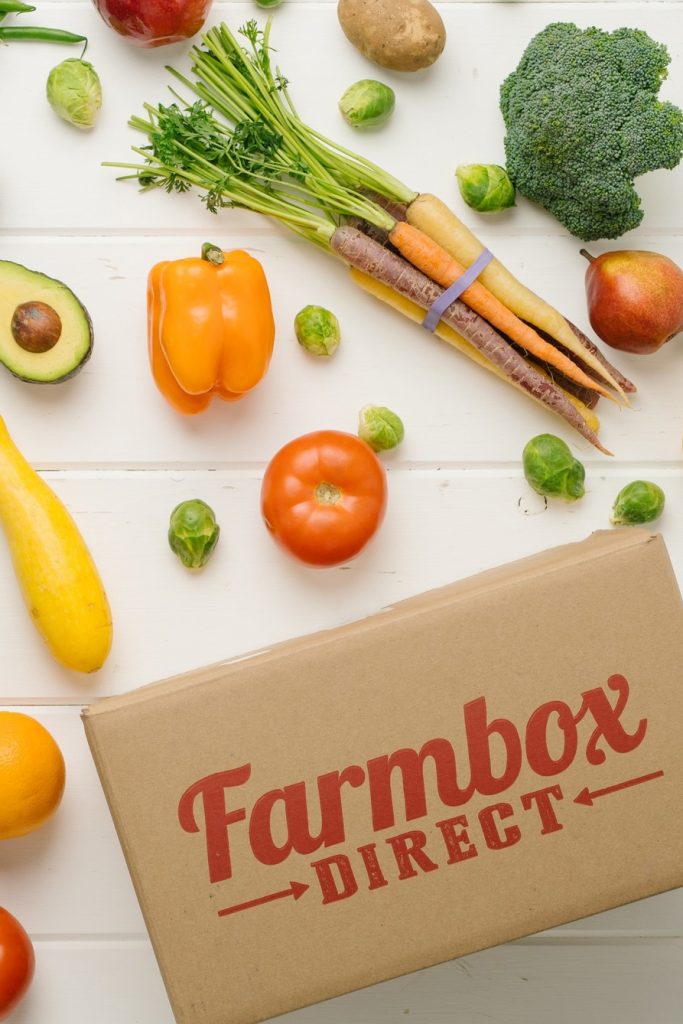
What is it? Natural and organic produce subscription delivery service.
Features:
- You have the option of choosing between “Organic,” which contains 100% USDA certified organic produce, and “Natural,” which is a more affordable option.
- The menu changes weekly, according to what’s in season. You’re emailed at the beginning of each week so you can make any substitutions.
- Produce is locally sourced in the Northeast U.S.
Ships to: Continental United States
Model: Weekly subscription. Here’s how it works:
- You choose the type (fruit, veggies, or both) and the size (small, medium, or large) of produce box you want.
- Choose up to 5 substitutions, if you’d like.
- Delay or cancel a shipment at any time.
How much does Farmbox Direct cost? Boxes range from $33 (for the “All Natural Essential” box) to $69 (for the “Only Organic Large Box”)
Cons:
- There is a small ($5.95) packaging and handling fee.
- Might be cheaper to get your produce from a more local CSA if you’re not in the Northeast U.S.
BEST FOR: Produce!
Misfits Market
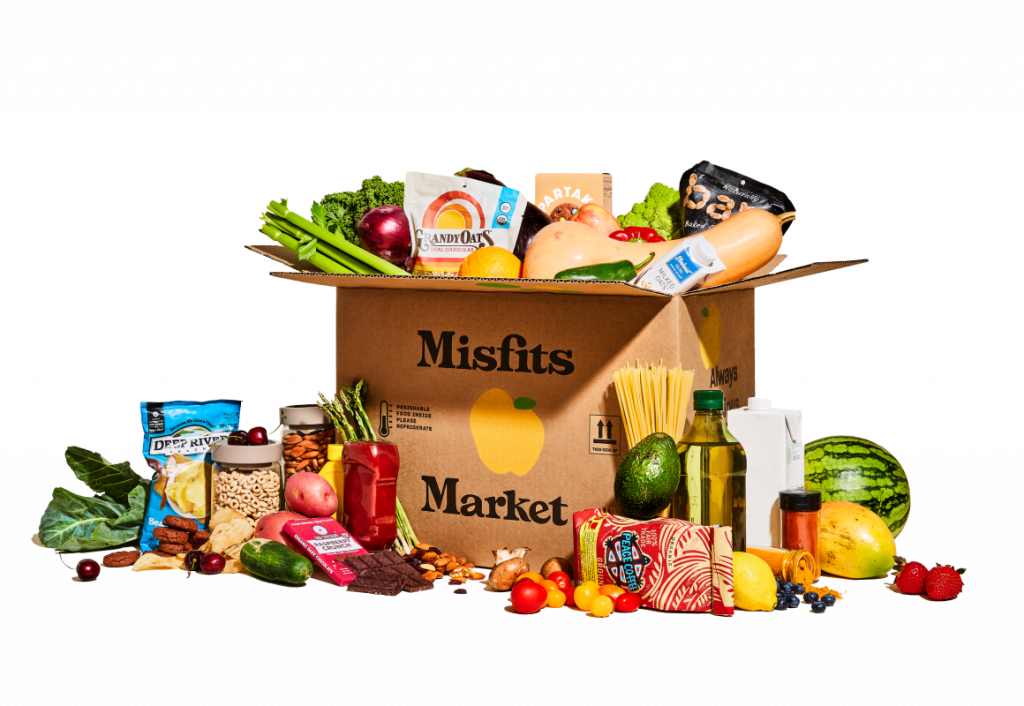
What is it? An organic produce subscription service that delivers “ugly” (but perfectly good!) produce to your door.
Features:
- Misfits Market cuts down on food waste (and therefore CO2 emissions as well) by collecting organic fruits and vegetables that “look strange” and have been rejected by grocery stores and supermarkets. This produce is just as healthy and safe to eat as “pretty” produce.
- Everything is organic, non-GMO, and grown in America.
- Delivers to rural areas that other “ugly” produce brands do not yet deliver to.
- More affordable option than other organic produce delivery services.
- You can choose what comes in your box.
- Eco-conscious packaging.
Ships to: Most zip codes in most continental U.S. states (though not all).
Model: Subscription. Here’s how it works:
- Choose a smaller “Mischief Box” or larger “Madness Box” of produce.
- Choose if you’d like to have it delivered every week or every other week.
- Skip a week or cancel at any time.
What does Misfits Market cost? The “Mischief Box” costs $22 and the larger “Madness Box” costs $35. In general, Misfits Market product is 25-40% less than the same produce from your local grocery store.
Cons:
- Small shipping fee ($5.50).
BEST FOR: Affordable organic produce!
Purple Carrot

What is it? Meatless meal kit delivery subscription service.
Dietary Needs & Preferences: Purple Carrot carries meal kits for the following dietary needs and preferences:
- High-Protein
- Gluten-Free
- Quick & Easy
- Chef’s Choice
Features:
- One of the first meal kit delivery companies to focus on vegan and vegetarian options.
- Menu changes frequently to keep things fresh.
- Free shipping
Ships to: Contiguous U.S.
Model: Subscription. Here’s how it works:
- Pick a plan, or customize your order every week.
- Choose if you want to add breakfast or lunch.
- Skip deliveries or cancel your subscription at any time.
How much does Purple Carrot cost? $9.99 to $11.99 per serving.
Cons:
- Less transparent about sourcing. Not all produce is organic, and it can be difficult to tell which items are organic and which ones are not.
- Some say the recipes lack flavor and you may want to add some extra spice.
BEST FOR: Vegan & vegetarian meal kits!
Local Farmer or C.S.A.
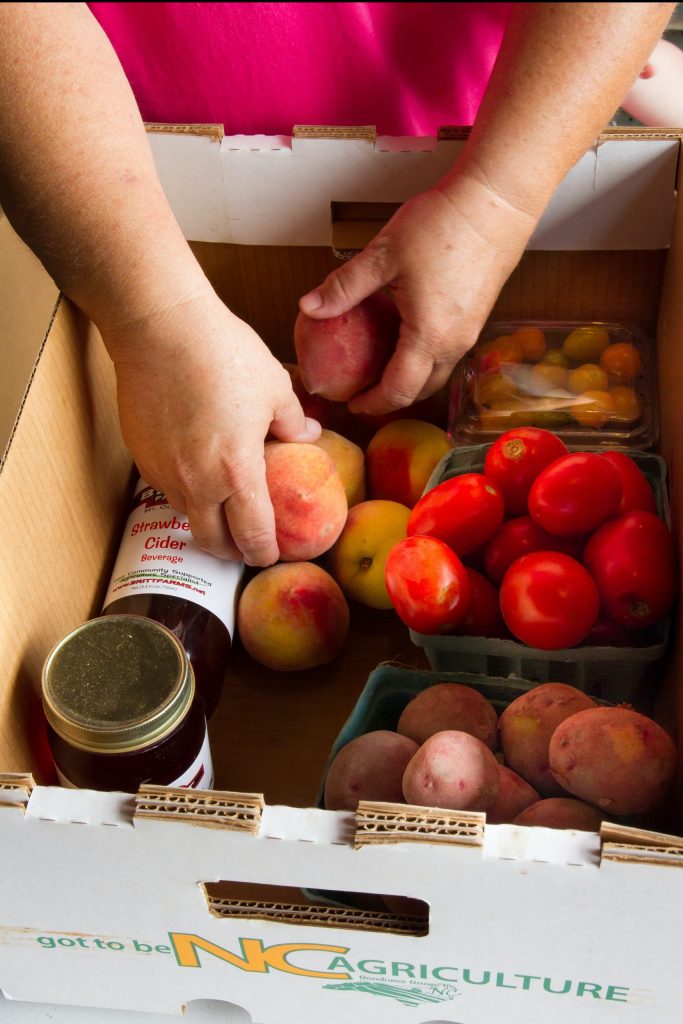
When it comes to purchasing produce, meat, and dairy products, shopping from a local organic or regenerative farmer can be the best option if it’s available to you! Community Support Agriculture (C.S.A.) programs allow you to pre-purchase a certain amount of food for the season, which helps to make sure the farmers have what they need to get the growing season going.
Shopping locally when possible not only cuts down on carbon emissions but also supports your local economy and and contributes to food sovereignty. All of this helps to cultivate a healthier and more eco-conscious community and economy as a whole.
Not only that, but it can make healthy eating incredibly affordable! By shopping from small local farms, you’re cutting out the middlemen, extra shipping costs, and more. And don’t forget to ask your local farmer if they use organic growing methods; they may do so without a certification!
To locate a CSA in your area, you can use a tool like LocalHarvest or Fair Share Farm Search. Or, simply search for “CSA near me” or “organic farm [city].
PIN IT:
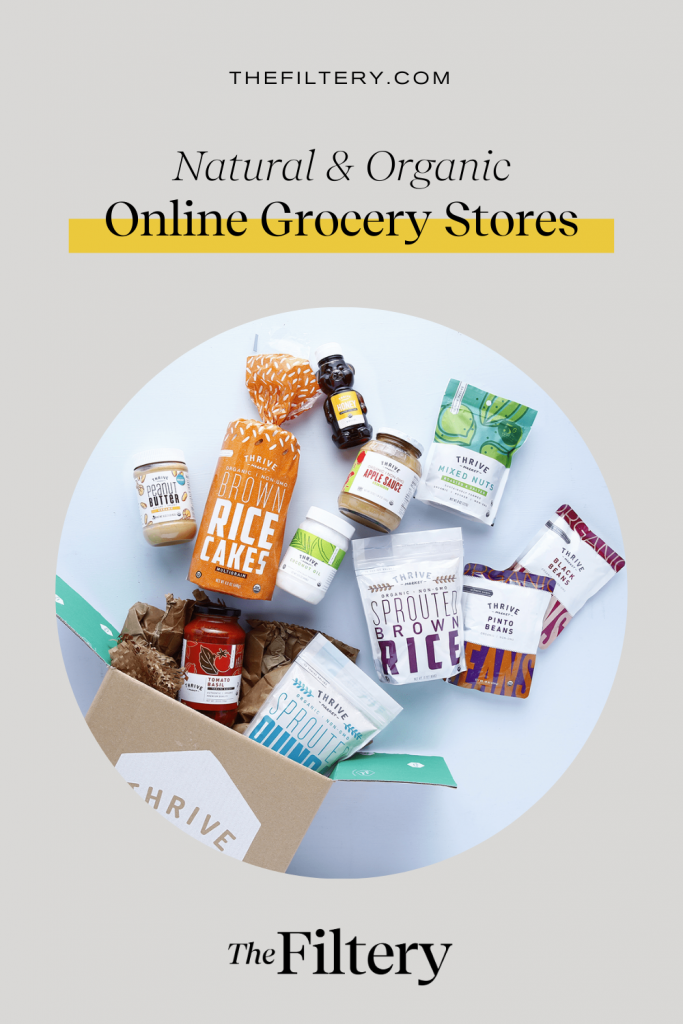
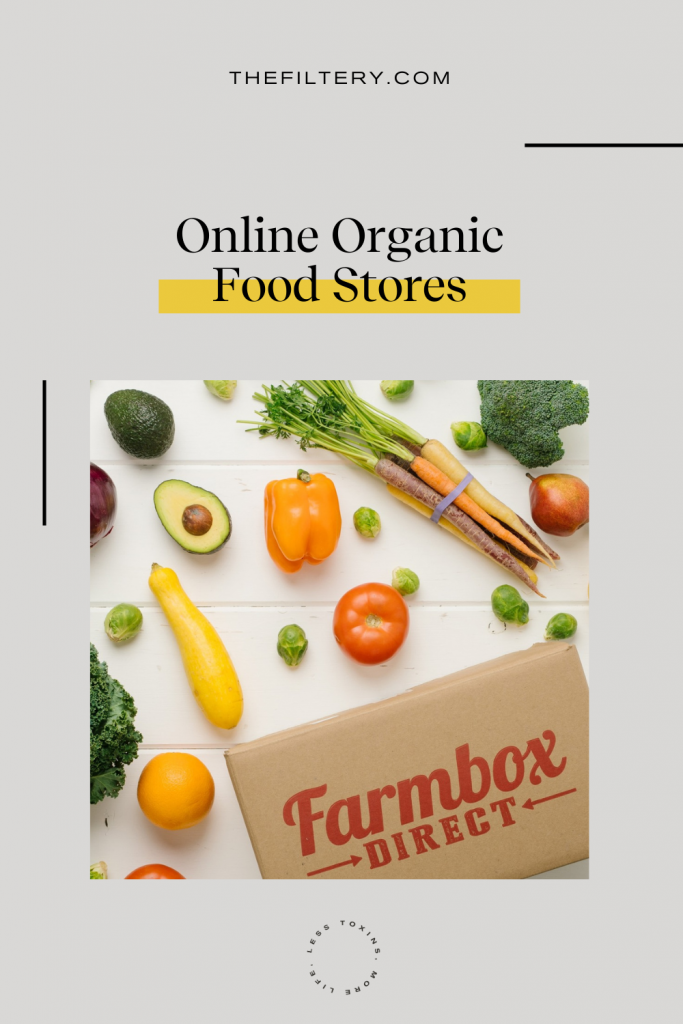
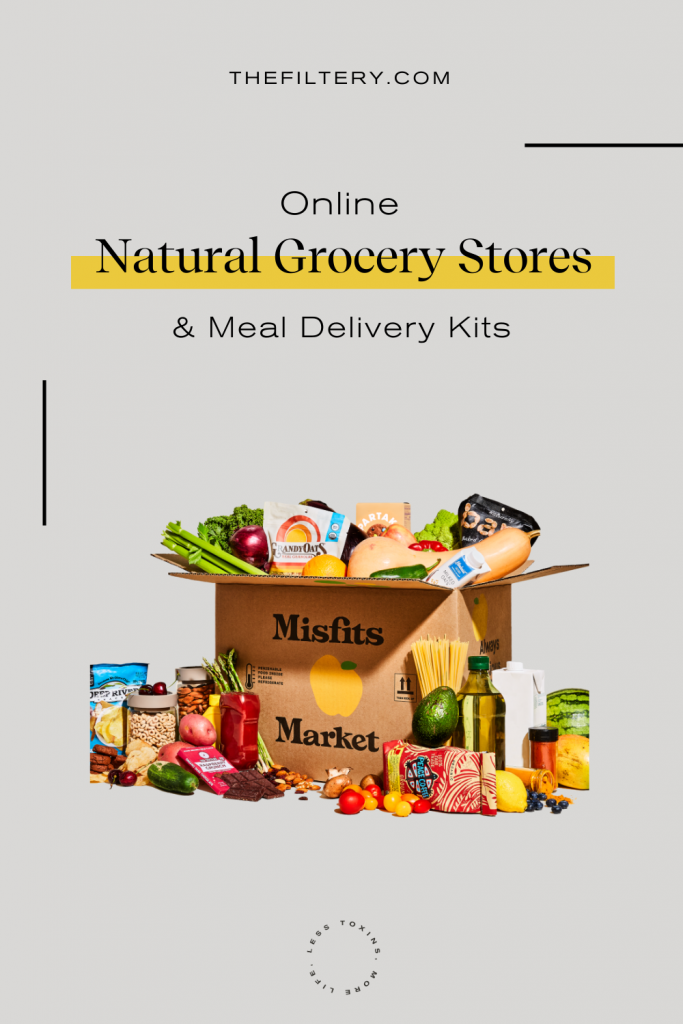
Image Credits: Lisa Fotios, Mark Stebnicki, all product images belong to respective brands




